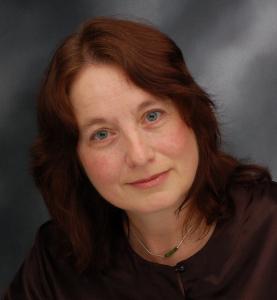
KAREN MAITLAND – A BIOGRAPHY
Karen Maitland travelled and worked in many parts of the United Kingdom before she began writing in 1996. She lived for many years in the beautiful medieval city of Lincoln, an inspiration for her writing. She is the author of The White Room, Company of Liars, The Owl Killers, The Gallows Curse, The Falcons of Fire and Ice and The Vanishing Witch. She has recently relocated to a life of rural bliss in Devon.
Don’t miss Karen’s regular blog at www.the-history-girls.blogspot.co.uk and visit her website www.karenmaitland.com for a treasury of weird and wonderful medieval facts and superstitions.
Interview with Karen Maitland
I’d like to welcome Karen Maitland to bibliobeth today and thank her for her time for this interview.
1.) In The Raven’s Head, the raven is a powerful superstitious symbol that causes many to shrink away with fear. As with all your previous novels, the amount of meticulous research you must have had to do is obvious but what is the most shocking or surprising medieval superstition you have discovered?
When I first discovered this it sounded quite harmless – When they were building a cathedral, church, manor or castle, they would trick some unsuspecting man into standing so that his shadow fell on the ground where they intended to lay the foundation stone. Innocent enough, except that medieval builders believed that person they’d tricked would die within the year, because they had stolen his soul and built it into the foundations to keep the building from collapsing. The victim’s spirit would be forced to guard that spot alone for all eternity. When you think about it, if they really believed that was what they were doing, it was almost worse than murder.
It is also the physical cruelty of some superstitions that I find shocking – To prevent witches or their spells entering the house you had to pull the guts and organs from a living dove and hang them over the door of your house. If you thought someone had cast a spell to make your chickens sick, or your cows’ milk dry up, then you were advised to take chicken from that flock and roast it alive or bury a calf from the herd alive to break the spell.
I suppose compared to the torture, burning and mutilations inflicted on human felons and prisoners of war by medieval kings and bishops, this was no worse. And, sadly, watching the news makes me think we are still often as cruel today.
2.) One of the main characters in the novel is a seventeen year old boy called Vincent, a librarian’s apprentice who plays a large part in the novel’s proceedings. How easy did you find it to get a 13th century young male voice right?
Bizarrely, I always find writing male characters easier than female and I know many male authors who find it easier to write women, perhaps because writing fiction is like acting. You have to become the character and think yourself into the character’s mind. It’s easier to do that when the character is very different from you. If they’re too similar you tend to self-censor your writing and stop yourself revealing certain thoughts or feelings.
I read as many medieval records as I could about the relationships between masters and apprentices in the Middle Ages, and what struck me that medieval adults used to complain about young people turning up late, skiving off and hanging around on street corners getting drunk. Sound familiar? The difference was that medieval masters were allowed to beat their apprentices and if they committed a serious crime they could even be hanged, which means Vincent would have had all those feelings of teenage resentment and rebellion – human nature doesn’t change – but he couldn’t rebel openly at first, not until he had a hold over his master. So I thought he’d confide to the readers exactly what he thought of that crabby old librarian.
3.) The descriptions of certain foods in the novel are so evocative and include things like roasted sheep’s feet, roast lark’s tongue and sea-swine. If you were at a medieval feast, what food would you be curious to try and which would have you running for the hills?
The coffin of lampreys would definitely put me off, knowing that it was made by drowning lampreys in their own blood, before baking. Medieval nobility loved strong flavours and birds such as cormorants were very popular on wealthy tables. But having once been a cottage in Scandinavia where a dead cormorant was being burned as candle, and remembering its nauseating oily-fish smell, I think I’ll give that cormorants a miss too.
And I don’t think I could manage to keep down slices of brawn made from pig’s fat and brains, dipped in extremely sugary batter, deep fried, then tossed in more sugar. And we worry about the fat in modern diets!
But many of their sauces had a more interesting flavor combination. One version of Sauce Madame, generally used for birds such as goose, included parsley, hyssop, savoury quinces, roasting pears, roasted grapes, wild garlic and onions, all seethed in wine, seasoned with salt and vinegar and thickened with egg yolks.
And Rosee sounds beautiful. It was a pudding made from the petals of sweet-smelling white roses, pine nuts, dates, cinnamon, ginger, sugar, almond milk and thick cream, cooked till it was like whipped cream, then served cold, decorated with fresh flowers.
(bibliobeth: “Mmm, sounds yummy!”)
4.) I loved the ending of this novel and felt it really left things open for a potential return of the characters. Would you ever consider writing a sequel for any of your books?
‘The Raven’s Head’ is the first book I’ve written for which I would like to write a sequel. Several of the characters are quite young at the end of the novel, and as an author and, by training, a psycholinguist, I am curious to find out what effect the traumatic events they’ve battled through will have on them. What kind of adults will it turn them in to? They each have potential they never had at the beginning of the story, but will it turn out to be for good or evil. For at least one of them, I think the future they might shape for themselves could be darker than the past they have lived through. But I don’t as yet know which of them that will prove to be.
5.) Are you working on anything at the moment and can you tell us a little bit about it?
Yes, I’m writing a brand new medieval thriller set in the 14th century. But it is too soon to talk about it, as I am still getting to know the characters and discovering where the plot is leading. Talking about a novel before it has been properly fired and hardened can destroy it. It’s like trying to pick up a spider’s web in your hand.
But I can tell you is it is set in on the coast in a real medieval village near Exmoor, a village which has a strange history. So, this time I am researching superstitions and folklore to do with the sea and also Exmoor ponies. I’ve learned that they weren’t called ponies until the 17th Century and were known locally as widgebeasts. Isn’t that a great name for those shaggy little animals?
(bibliobeth: “Absolutely! Ooh, very intrigued now.”)
And now for some quick-fire questions…
E book or real book?
Real book. Never read an e-book. Don’t exist in my world which is the Middle Ages.
Series or stand-alone?
Stand-alone. Except for Harry Potter, and Susan Cooper’s – ‘The Dark is Rising’.
Fiction or non-fiction?
Both. I always have one of each in my bag.
Online shopping or bookshop trawling?
Bookshop addict. I never shop online.
Bookmarking or dog-earing?
Bookmark with old envelopes or bus tickets, but never with kippers.
Once again, a big thank you to Karen for her efforts in making this interview possible and I’m incredibly excited now for the next book.
The Raven’s Head was published on 12th March 2015 and is available from all good retailers NOW.

